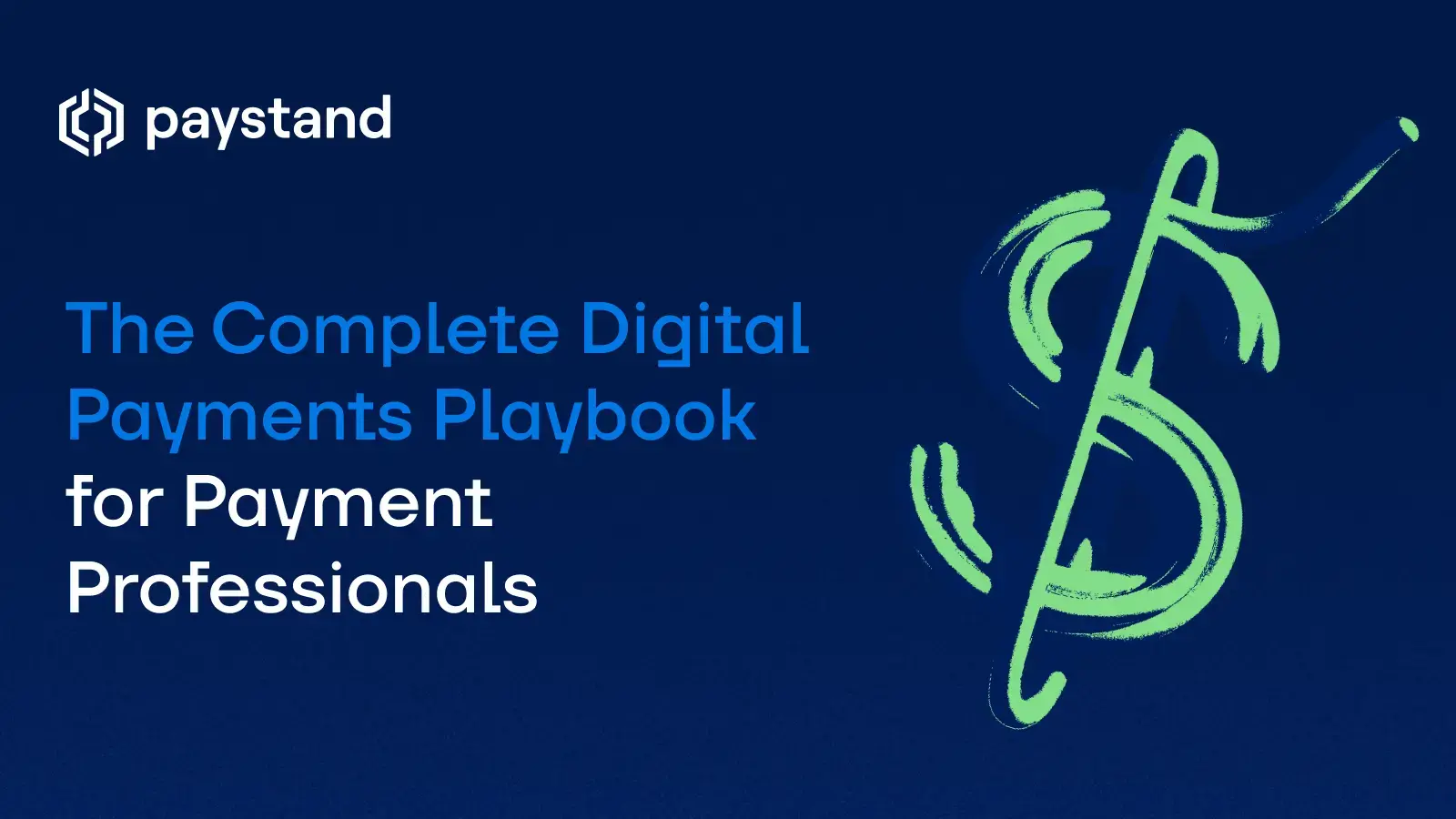The Complete Digital Payments Playbook for Payment Professionals

Table of Contents
- What Are Digital Payments?
- How Digital Payments Work
- Security, Compliance, and Risk Management
- Types of Digital Payments Business Owners Know
- Understanding Digital Payment Costs
- Benefits of Digital Payments for Businesses
- Getting Started with Digital Payments
- Simplify Digital Payment Adoption and Accounts Receivable With Paystand
Key Takeaways
- Digital payments streamline AR processes and accelerate collections.
- 40% of B2B payments remain manual despite efficiency gains in digital transactions.
- Digital payment platforms enhance cash flow, security, and ERP integration.
- Paper checks are costly, slow, and the top source of B2B payment fraud.
- Paystand offers an automated B2B payment solution for optimized cashless transactions.
Imagine two businesses sending invoices today. One receives payment instantly, the other waits days for checks to clear. This difference often comes down to digital payments.
This guide explains what digital payments are, how they work, and why they matter for organizations of all sizes. You will gain an understanding of the technology, terminology, and practical realities that shape how money moves electronically today.
What Are Digital Payments?
Digital payments are financial transactions that happen electronically without using physical cash or paper checks. These transactions rely on digital devices such as smartphones, computers, tablets, or payment terminals connected to the internet or other digital networks.
A digital payment occurs any time money moves electronically from one person or business to another. This includes payments made through card networks like Visa or Mastercard, mobile apps such as Apple Pay or Google Pay, direct bank transfers, or digital wallets.
Unlike traditional payment methods, digital payments happen without exchanging physical items. They are processed quickly, can be tracked in real time, and often connect directly with business systems for easier recordkeeping.
Common examples of digital payments include:
- A customer tapping a phone to pay at a coffee shop
- A business paying a supplier through an online bank transfer
- An online shopper checking out with a saved credit card
- Friends splitting a dinner bill using a peer-to-peer app like Venmo
Each uses electronic systems to move money between parties.
How Do Digital Payments Differ from Checks?
|
Feature |
Digital Payments |
Checks |
|
Processing Time |
Instant to 1-2 days |
5-15 days |
|
Security |
High (encryption, fraud detection) |
Low (susceptible to tampering) |
|
Cost Efficiency |
Low transaction fees |
$4-$20 per check |
|
Automation |
Fully automated |
Manual processing |
|
Fraud Risk |
Low |
High (73% of fraud cases) |
How Digital Payments Work
Digital payments involve four main parties working together to move money electronically. Understanding these roles helps explain why transactions happen quickly and securely.
The Key Players in Digital Payment Transactions
The customer or cardholder initiates the payment by providing payment credentials like card numbers or bank account details. The merchant or business receives the payment for goods or services provided.
Payment processors and gateways handle the technical work. Payment gateways collect and encrypt payment information from customers, while payment processors route transactions through the correct financial networks.
These companies work with multiple banks and card networks to complete transactions.
Financial institutions include the issuing bank, which provides the customer's payment method, and the acquiring bank, which receives funds from the merchant.
These banks verify account details, check for available funds, and transfer money between accounts.
The Transaction Journey From Start to Finish
Every digital payment follows the same basic path, though it happens in seconds.
- Authorization begins when a customer provides payment credentials by swiping a card, entering details online, or using a mobile wallet. The payment gateway encrypts this information and sends it through the payment network.
- The issuing bank receives the request and checks that the account is valid, has sufficient funds, and shows no signs of fraudulent activity. The bank approves or declines the transaction, typically within two to three seconds.
- Clearing happens next as approved transaction details are grouped and exchanged between the acquiring and issuing banks, usually at the end of the business day.
- Settlement completes the process when funds are transferred from the customer's account through the payment network to the merchant's account. While authorization happens almost instantly, settlement can take one to three business days, depending on the payment method.
Security, Compliance, and Risk Management
While digital payments offer tremendous convenience and efficiency, they also introduce significant security risks and regulatory obligations that businesses cannot afford to ignore.
Understanding the security technologies that safeguard transactions and the compliance frameworks that govern payment processing is essential for any modern business.
Security Standards and Technologies
PCI DSS (Payment Card Industry Data Security Standard) serves as the foundational security framework that all businesses accepting card payments must follow. Compliance requirements are scaled across four levels based on annual transaction volume.
Modern payment security relies on several critical technologies working together.
- End-to-end encryption scrambles sensitive data during transmission, rendering any intercepted information completely useless to fraudsters.
- Tokenization replaces actual card numbers with randomly generated tokens for storage and recurring billing purposes, ensuring that even if systems are breached, no usable payment data is exposed.
- EMV chip technology embedded in modern cards creates unique transaction codes that make card counterfeiting virtually impossible, unlike older magnetic stripe technology.
- Multi-factor authentication adds extra verification steps—such as SMS codes or authentication apps—for high-risk transactions.
- Biometric authentication methods, including fingerprint and facial recognition, have become increasingly standard in mobile payment applications, offering both enhanced security and user convenience.
The good news for merchants is that modern payment processors build these protections directly into their platforms, meaning you don't need deep technical expertise to benefit from enterprise-grade security.
Regulatory Compliance Requirements
Businesses accepting digital payments must navigate an increasingly complex web of regulatory frameworks designed to protect consumers and prevent financial crime.
In Europe, PSD2 (Payment Services Directive 2) mandates Strong Customer Authentication for most electronic payments, requiring two independent verification factors that add some transaction friction but dramatically reduce fraud rates.
Payment processors must fulfill KYC (Know Your Customer) and AML (Anti-Money Laundering) requirements, implementing robust identity verification procedures and sophisticated transaction monitoring systems that flag suspicious activity patterns for investigation.
Data protection regulations have become equally critical, with GDPR in Europe and various state-level privacy laws throughout the US imposing strict requirements on how payment data must be collected, processed, stored, and eventually deleted.
Beyond these widely applicable standards, region-specific regulations add further complexity—India's UPI system operates under specific Reserve Bank guidelines, while China requires special licensing for payment operations.
The reassuring reality is that reputable payment processors shoulder most of this compliance burden, maintaining certifications and building regulatory requirements into their systems.
However, merchants remain responsible for verifying their provider's compliance status, understanding their own data handling obligations—because non-compliance can result in substantial fines, processing restrictions, or reputational damage.
Types of Digital Payments Business Owners Know
Different digital payment methods serve different business purposes. Understanding the options helps you choose the right mix for your customers and operations.
Card-Based Payments
Credit cards, debit cards, and contactless cards are the most established digital payment category. Card payments use networks such as Visa, Mastercard, American Express, and Discover to move money between banks.
Key differences include:
- Credit cards: Allow borrowing against a credit line with interest charges
- Debit cards: Transfer funds directly from bank accounts at transaction time
- Contactless cards: Use NFC technology for tap-to-pay convenience
Card payments include consumer protections through chargeback rights, which allow customers to dispute transactions.
Digital Wallets and Mobile Payments
Digital wallets store payment information on smartphones or other devices. Popular examples include Apple Pay, Google Pay, Samsung Pay, and PayPal.
These wallets use tokenization, replacing real card numbers with random codes during transactions. This makes payments more secure because merchants never receive actual card details.
Mobile wallets work in stores through NFC technology and online through simplified checkout processes.
Biometric authentication like fingerprints or facial recognition adds security layers. QR code payments are also common, especially in Asian markets where users scan codes to complete transactions.
Bank Transfers and Direct Payments
Bank transfers move money directly between accounts without card networks. In the United States, the Automated Clearing House (ACH) network processes these transfers. Europe uses the Single Euro Payments Area (SEPA) system.
Bank transfer characteristics include:
- Lower fees: Often flat rates or small percentages compared to card processing
- Slower settlement: Typically 2-5 business days for ACH transfers
- Higher values: Preferred for large B2B transactions where percentage fees matter
- Direct debit: Allows businesses to pull authorized payments from customer accounts
Wire transfers handle urgent, high-value transactions with faster processing but higher costs.
Alternative Payment Methods
Buy Now, Pay Later (BNPL) services like Affirm, Klarna, and Afterpay split purchases into installments. These services appeal to customers seeking payment flexibility while potentially increasing merchant sales.
Peer-to-peer (P2P) payment apps like Venmo, Cash App, and Zelle enable direct money transfers between individuals. Small businesses increasingly use these apps for simple transactions.
Cryptocurrency payments using Bitcoin, Ethereum, or stablecoins remain experimental due to price volatility and regulatory uncertainty, though adoption is growing in some industries.
Understanding Digital Payment Costs
Payment processing involves multiple cost components that affect business profitability. Understanding these expenses helps companies make informed decisions about payment methods and providers.
Transaction Fees and Processing Rates
Interchange fees are the largest cost component, set by card networks and paid to issuing banks. These typically range from 1.5-3% depending on card type and transaction risk factors.
Assessment fees are smaller percentages charged by card networks like Visa and Mastercard. Processor markup covers the payment processor's services and represents the negotiable portion of costs.
Pricing models vary:
- Flat-rate pricing: Simple percentage plus fixed fee (like 2.9% + $0.30)
- Interchange-plus pricing: Transparent pass-through of interchange fees plus processor markup
Different payment methods carry different costs. Credit cards typically cost the most, debit cards less, and ACH transfers the least, but with slower processing.
Hidden Costs and Chargebacks
Chargebacks occur when customers dispute transactions through their banks. The full cost includes the refunded transaction amount, chargeback fees ($15-100 per incident), lost merchandise, and administrative time for dispute resolution.
Additional hidden costs include:
- Currency conversion fees for international transactions (1-3%)
- Equipment rental or purchase for payment terminals
- Integration costs for e-commerce platforms
- Monthly account maintenance fees
Excessive chargebacks (typically above 1% of transactions) can result in higher processing fees or account termination.
Benefits of Digital Payments for Businesses
Digital payments create measurable advantages across multiple business operations. These benefits extend beyond simple transaction processing to impact cash flow, security, and competitive positioning.
Faster Cash Flow and Working Capital
Digital payments fundamentally transform business cash flow by settling transactions in one to three business days compared to the weeks required for check processing and clearance.
This acceleration directly improves working capital management, reducing days sales outstanding (DSO) and providing businesses with faster access to earned revenue.
You can reinvest funds more quickly, meet payroll obligations without delay, pay suppliers promptly to capture early payment discounts, and maintain healthier cash reserves without resorting to expensive short-term financing.
The predictability of digital settlement schedules also enables more accurate cash flow forecasting, allowing finance teams to plan expenditures and investments with greater confidence.
Enhanced Security and Fraud Prevention
Digital payment systems provide dramatically superior security compared to traditional paper methods, leveraging end-to-end encryption and tokenization technologies that make intercepted data useless to criminals.
Paper checks, by contrast, expose bank account numbers, routing information, and signatures that fraudsters can exploit. Digital transactions create encrypted audit trails that enable rapid fraud detection and investigation, while tokenization ensures that stored payment credentials cannot be weaponized even if databases are breached.
Multi-factor authentication and behavioral analysis add additional protective layers, flagging suspicious transactions before funds transfer.
The reduced fraud risk translates directly to bottom-line savings by eliminating losses from counterfeit checks, altered payment amounts, and identity theft schemes that plague paper-based systems.
Operational Efficiency and Automation
Digital payments eliminate countless hours of manual work by automatically recording transactions in real-time, removing the need for staff to manually enter payment data and reconcile bank deposits.
Real-time reporting dashboards provide instant visibility into revenue, outstanding invoices, and payment trends, enabling managers to make informed decisions without waiting for month-end accounting closes.
Integration with popular accounting platforms like Sage, Acumatica, and Dynamics 365 automates reconciliation processes that traditionally consumed significant finance team bandwidth.
Businesses can automatically match incoming payments to specific invoices, flag exceptions requiring attention, and generate financial reports with current data rather than outdated information.
The time savings compound across the organization, allowing staff to focus on strategic activities rather than administrative drudgery.
Expanded Market Reach and Revenue Opportunities
Digital payment acceptance removes geographical barriers that limit business growth, enabling companies to generate revenue 24/7 without physical presence or staff availability.
Digital payments also reduce per-transaction handling costs. Human error diminishes substantially when systems automatically capture and transmit payment data rather than relying on manual reading and entry of handwritten checks.
These capabilities level the playing field, allowing businesses to operate with the reach and professionalism previously available only to large enterprises.
Competitive Necessity and Customer Expectations
Businesses without digital payment options face serious competitive disadvantages as customers increasingly expect frictionless payment experiences and will readily switch to competitors who provide them.
This expectation spans all demographics, not just younger consumers but also older customers who've grown accustomed to convenient digital transactions. Beyond preventing lost sales, digital payment systems generate valuable customer data and transaction insights.
This data enables targeted marketing, inventory optimization, pricing strategies, and personalized customer experiences that drive competitive advantage. Businesses leveraging these insights make smarter decisions about product development, promotional timing, and customer retention strategies.
Customer Convenience and Accessibility
From the customer perspective, digital payments deliver unprecedented convenience by enabling instant transactions from any location at any time, eliminating the need to carry cash, visit bank branches during business hours, or remember to mail checks before due dates.
Digital payments also simplify expense management for business travelers and consumers alike, providing automatic electronic records that eliminate the need to save receipts or manually log expenditures.
Payment Flexibility and Financial Control
Digital payment ecosystems provide customers with unprecedented flexibility to choose their preferred payment method. Credit card users accumulate rewards points, airline miles, or cashback that effectively discount purchases, while simultaneously enjoying fraud protection, extended warranties, and dispute resolution services unavailable with cash transactions.
Digital payment records automatically create detailed expense tracking that simplifies budgeting, tax preparation, and financial planning without manual categorization or envelope systems.
Customers gain spending visibility through banking apps that instantly reflect transactions, send spending alerts, and provide categorized summaries, supporting better financial decision-making and preventing overdrafts that plague manual tracking systems.
Speed and Simplicity Benefits
Digital payments eliminate the tedious friction of traditional payment methods. Transactions complete in seconds rather than requiring multiple steps across multiple days, dramatically reducing the time customers spend managing financial obligations.
This speed benefit extends throughout the payment lifecycle: bills arrive via email rather than postal mail, payments process with a few taps or clicks, and confirmation appears instantly rather than requiring cleared check verification.
Getting Started with Digital Payments
Implementing digital payments requires evaluating business needs, selecting appropriate providers, and managing technical integration. A systematic approach ensures the chosen solution matches operational requirements.
Assess Your Business Requirements
Start by examining your business model, whether e-commerce, brick-and-mortar, B2B, subscription-based, or hybrid operations. Consider typical transaction amounts and volumes, customer payment preferences, and geographic markets served.
Identify essential features versus nice-to-have capabilities. Some businesses require recurring billing or multi-currency support, while others need in-person terminals or online-only processing.
Review current payment methods to identify where customers abandon purchases, what payment requests you receive, and which manual processes consume staff time.
Choose the Right Service Provider
Compare providers across key criteria, including pricing structure, supported payment methods, settlement speed, and integration capabilities with existing systems.
Evaluation factors include:
- Pricing: Flat-rate versus interchange-plus models
- Payment methods: Cards, wallets, ACH, international options
- Settlement speed: How quickly funds reach your account
- Security: PCI compliance and fraud protection tools
- Support: Customer service availability and contract flexibility
All-in-one solutions work well for straightforward needs, while specialized providers serve specific industries or high-volume operations.
Implementation and Technical Setup
E-commerce businesses can choose hosted payment pages, payment gateway APIs, or platform plugins for systems like Shopify, Adobe Commerce, or WooCommerce. In-person businesses select from countertop terminals, mobile card readers, or integrated point-of-sale systems.
Test all payment methods in sandbox environments before going live. Verify that transactions process correctly, data flows to accounting systems, and customer receipts are generated properly.
Payment providers typically require business documentation for account approval, including business registration, tax identification, and bank account information. Approval times vary based on business risk profile.
Simplify Digital Payment Adoption and Accounts Receivable With Paystand
Most businesses struggle with digital payments and accounts receivable existing as disconnected silos, forcing finance teams to reconcile transactions manually, chase down payment details, and cobble together insights from multiple systems.
Paystand eliminates this friction by unifying payment acceptance and AR management into a single intelligent platform:
- Zero-fee B2B payments through blockchain-powered infrastructure that eliminates traditional processing costs while accelerating settlement to same-day or next-day timelines
- Automated AR workflows that send smart invoices, apply payments instantly, reconcile transactions automatically, and provide real-time visibility into cash flow and outstanding receivables
- Flexible payment options, including ACH, credit cards, digital wallets, and paper checks—all flowing into one consolidated system that customers access through branded payment portals
- Seamless ERP integration with QuickBooks, NetSuite, Sage Intacct, and other accounting platforms, ensuring payment data synchronizes bidirectionally without manual intervention or data entry
Discover how Paystand can transform your payment operations from a cost center into a competitive advantage through AR automation.







